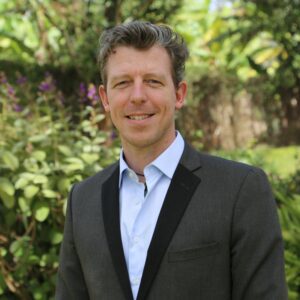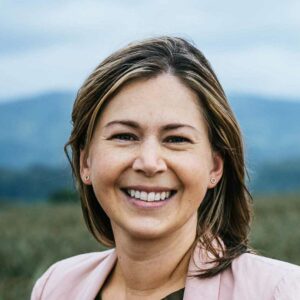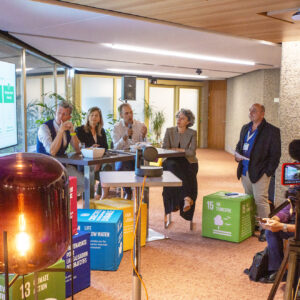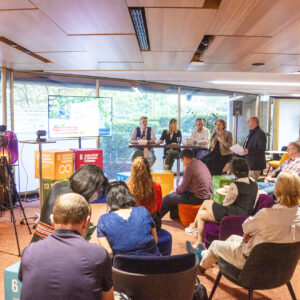Événement Conférence
The Value of Nature: Finance for Biodiversity | INTECOL 2022

30 Aug 2022
17:30–19:00
Lieu: Centre International de Conférences Genève (CICG) & Online | Webex & Online | Webex
Organisation: Geneva Environment Network, International Association for Ecology
Bridging the INTECOL and Geneva communities together, the Geneva Environment Networking Bars are held in the margins of INTECOL 2022: “Frontiers in Ecology: Science and Society”, hosted by the University of Geneva and its partners, at the Geneva International Conference Center in Geneva (CICG), from 28 August to 2 September 2022. These networking sessions open to Geneva stakeholders discussed topics that are at the center of the global environmental agenda.
Geneva: Global Hub for Environmental Governance
Environmental issues entered the international agenda in the early 1970s, but even prior to that, institutions based in the Geneva region have greatly contributed to develop the global environmental governance system. Since then, the Geneva region has hosted various historical meetings and negotiations, and welcomed new organizations focusing on environmental-related issues.
Today, the “Grand Genève” region, where many international organizations, forums, federations and non-governmental organizations have their headquarters, continues its role as an important center for international environmental policy.
INTECOL 2022 in Geneva
The International Congress of Ecology 2022 (INTECOL 2022), hosted by the University of Geneva and its partners, will take place from 28 August to 2 September 2022 at the CICG Geneva – Geneva International Conference Center in Geneva, under the theme “Frontiers in Ecology: Science and Society”.
Geneva welcoming INTECOL 2022 is therefore an opportunity to link the INTECOL and Geneva international communities on topics that are at the center of the global environmental agenda.
Two hybrid networking sessions – Geneva Environment Networking Bars – open to Geneva communities were proposed in the margins of INTECOL 2022. These sessions were facilitated by the Geneva Environment Network (GEN) and the University of Geneva. With the 8th edition of Alternatiba Leman taking place during the same week of INTECOL 2022, a special session also focused on synergies with local and global climate action.
About this Session
A total investment in nature of USD 8.1 trillion is required between now and 2050 – while annual investment should reach USD 536 billion annually by 2050 – to successfully tackle the interlinked climate, biodiversity, and land degradation crises, according to the State of Finance for Nature report released in May 2021.
This session involved key Geneva-based institutions, looking at private nature-finance approaches, including public incentives for private finance: bringing nature to the heart of financial decision-making, highlighting latest developments in placing financial value on biodiversity, and redirecting financial flows across the global economy towards nature-positive solutions.
Organized a few weeks ahead of the United Nations Environment Programme Finance Initiative Global Roundtable 2022 – the major global agenda-setting event on sustainable finance, Building Bridges 2022 – a Geneva-based initiative that aims to accelerate the transition to a global economic model aligned with the SDGs, the UN Biodiversity Conference (CBD COP15), and the Sharm el-Sheikh Climate Change Conference (UNFCCC COP27), this event was the occasion to explore finance for nature.
Speakers

Anthony LEHMANN
Professor at the Institute for Environmental Sciences (ISE), University of Geneva | Moderator
Highlights
Ivo Mulder (@IvoMulder) of @UNEP's Climate Finance Unit highlights the importance of speeding and scaling up funding of governments & investments to act against the #climate and #nature crises. pic.twitter.com/hAxwdl0bGF
— GENeva Environment Network (@GENetwork) August 30, 2022
Summary
Welcome and Introduction
Anthony LEHMANN | Professor at the Institute for Environmental Sciences (ISE), University of Geneva | Moderator
- It was important to allow nature biologists attending INTECOL to know what is happening in the world of finance, looking at ecosystems, living organisms and the what the value of nature is and how it is looked at from this perspective.
- Important meetings related to this agenda are coming up, UN Biodiversity Conference COP-15, Climate Change COP-27 in Sharm El-Sheikh in November, the Global Roundtable on “Transforming Finance, Accelerating Change” in October and the Building Bridges initiative here in Geneva.
The State of Finance for Nature
Ivo MULDER | Head, Climate Finance Unit (CFU), UN Environment Programme
Working on the intersection between biodiversity, climate and finance for about 10-15 years in various capacities, in the last few years with UNEP, I’ve been helping build a number of funds and facilities to actively help catalyze public and private finance towards projects that have a positive impact on nature, climate, and rural communities.
We need a fundamental rethink and a paradigm shift in how we deal with biodiversity and climate in our societies and economic systems.
- About half our global economy is dependent on nature so despite the fact that scientists and the international community have been saying that it’s important, humanity hasn’t acted. We seem to be paralyzed: we know this is not good but we’re incapable of moving to the extent necessary, and the window available turn the tables around is quickly being diminished.
- UNEP is good at stating what the problem is, in putting out global reports on the Global Environmental Outlook, but what we need right now are the solutions. More attention and money will go towards organizations and businesses that do contribute to the problems we’re facing. The Climate Finance Unit has actively worked on a number of funds and facilities to catalyze private finance. We’re also contributing to normative changes and that includes the report “State of Finance for Nature” quantifying how much public employment capital flows are going towards nature-based solutions and putting that in the context of the Conventions around land degradation, nature and climate.
We’re contributing to creating social, environmental impact, communication, and building coalitions and partnerships around the State of Finance for Nature.
- This is a report that aims to quantify how much money is being invested into nature and nature-based solutions nature-based, from greening roofs in cities and ensuring green islands in cities, to investing in mangroves as a natural protection against storm floods. The amount we found with support of Vivid-McKinsey is around 130 billion dollars a year, most of that is in the form of government domestic spending and most of it in G20 countries.
- If you look at it how much money is actually necessary, there is at least a four-fold increase necessary to meet the biodiversity, climate and restoration commitments. Most of that investment needs are in non-G20 countries that have much less fiscal freedom to invest in nature. At the same time overseas development assistance (ODA) is not at the level where it needs to be to make that shift.
- Private investment in NbS has a small share of G20’s NbS spending at 11% (and 14%, based on the global report). The report shows that without the private sector and given that governments are in debt following the COVID-19 crisis, it is unlikely even though necessary for governments to massively scale public money. The interesting question is how do we incentivize private finance to do things differently from banks and investors to agribusinesses, etc.?
The Climate Finance Unit is a team of about 30 professionals in Geneva and in different locations.
- We’ve helped to unlock about 17 million in in public concessional finance over the past three years, which directly helped unlock 160 million in private capital and different kinds of funds. In terms of debt and equity in Brazil, Indonesia, China and Ecuador, that equals about 316 million. It’s a good achievement with a relatively small team but in the billions of changes that we need, it is, of course, a drop in the ocean.
- There are many other examples that are already happening to help unlock private finance, whether in private equity or in corporate lending as in sovereign bonds. An interesting sovereign bond launched by the World Bank called the rhino bonds where payments are dependent on the increase in populations of black rhinos. A lot is possible, but the speed of change is too slow for the urgency of the crisis that we’re facing. Both domestic spending by government ODA and private investment need to scale up. We need to revisit the under-valued and unappreciated topic is the notion of repurposing trade tariffs and agricultural fiscal policies.
Up-scaling Private Sector Financial Flows to Nature
Jessica SMITH | Nature Lead, UNEP Finance Initiative
UNEP FI works a lot with the mainstream financial sector (banks, insurers, and investors), and some of the coalitions that we operate are at a large scale, and not necessarily with impact investors. For example, the Principles for Responsible Banking signatories represent half of the world’s banking assets.
We’re working towards shifting finance from nature negative towards nature positive, and our approach to this is to look at the financial processes that the financial industry undertakes.
- As opposed to the terms used in ecological research, we try to approach this the way financial processes operate and to intersect this with nature. We talk about environmental assets and ecosystem services, which may be familiar, but we also talk about how economic activities depend on these environmental processes.
- We discuss what are the positive and negative impacts that are derived from economic activities that are financed, and the term risk is something that is quantified to be able to manage it within mainstream financial processes.
- There are also market opportunities for nature-based solutions and new types of investments. For example, in renewable energy, there are estimates that show new investments in nature could yield 10 trillion dollars and 350 million new jobs (WEF, 2020).
Because we’re talking about the private commercial financial sector, we’re really looking where financial flows, revenues, enterprise value are returning. As the UN, we’re looking from the perspective of how we can help the financial sector shift their financial flows towards meeting the SDGs 14 and 15. Now, we’re waiting for the “Paris moment” for nature through the global biodiversity framework expected by the end of the year. We see language in which is calling for the alignment of all financial flows towards the goal of stopping biodiversity loss and restoring nature. This is in essence a call to the financial sector to change the framework that they’re using and put biodiversity as an important outcome of these financial processes.
UNEP FI and Nature
- Aligning Financial Flows. At UNEP FI, our nature team focuses on this idea of aligning financial flows. We help financial institutions with portfolio targets, where a portfolio is measured against a certain nature-related goal (similar to how 1.5°C global warming limit goal is for the climate sphere), with the goal of being able to change how we invest, lend, and insure. We’re working towards that in different ecosystems for the industries that we work.
- Risk & Disclosure. A major undertaking of financial institutions to quantify, identify, and manage, risk and consider risk-adjusted returns. In asking “What information do you have that informs your understanding of risk?” one important factor is the idea of disclosure – disclosure by the clients that you are lending, investing in, and insuring – is extremely important.
- Through the Taskforce on Nature-related Financial Disclosures, we’ve tried to identify nature-related risks. We have a task force of market leaders from finance industry and service industries who are trialing and piloting a framework to identify and disclose nature-related risks in the climate space. This is now being taken up in regulation, and is becoming into law in countries like the UK and Switzerland, where you disclose the climate impacts of your financial portfolio.
- Policy Environment. This is basically having a conversation with regulators when voluntary commitments are made by the financial sector: how do we then embed those into normal policy and practice so they become industry-wide? This policy and regulation is ambitious and helps shift this finance, and building on momentum from private players.
- Thematic Work: Blue economy and food systems. It’s very important um to focus on the marine space given that 71% of the surface of our planet is marine areas. This is very tied to food production and climate regulation and other services. Moreover, because our food systems are both tied to climate and biodiversity outcomes, we focus quite a lot on that as well.
We have around 500 members that are mainstream banks and insurers. We also have the Investment Leadership Program with the Principles for Responsible Investment, reaching 5,000 investors. Amongst those members around 450 plus others have committed to align their entire portfolios to net zero on climate. We really want to look at nature-based solutions or natural climate solutions to make sure that biodiversity and nature are embedded in the commitments that they’ve already made, as research suggests that 37% of Paris Agreement solutions could come from nature and ecosystems.
On the Taskforce on Nature-related Financial Disclosures general risk framework. The website (tnfd.global) gives more information, but I want to highlight how this relates to ecology. There’s some correlation to what are being discussed in the conference. On idea of nature-based solutions, there’s certainly investment and new financial opportunities being trialed and tested: opportunities for sequestering carbon, building resilience and adaptation opportunities that can be provided by ecosystems. This shows the important relationship between the ecological research community and the financial sector to understand both where are those solutions in peatlands, mangroves and different ecosystems, but then also where the revenue flows are, which ones are bankable by the commercial private sector, and which ones need government support.
On the role of indigenous people and local communities (IPLCs) in nature finance.
Around a third of our terrestrial landscape and inland waters are managed by IPLCs. The role they play is extremely valuable, as studies have shown that indigenous people can be better at managing biodiversity than state protected areas, even when those areas aren’t managed for that specific purpose. This is an incredible outcome. When we look at where biodiversity is intact around the world, a lot of it is in the global south where customary 10-year arrangements or communal tenure has been in place. There’s a lot that we can learn from indigenous people and local communities, yet very few financial transactions are reaching those areas. They tend to reach to private land leasehold land commercial land.
One of the challenges here is that financial, environmental, and social risks – both the perception and the reality — haven’t been well cataloged or addressed. There isn’t a very strong relationship between the financial sector and the indigenous people. The goal is to bridge different time frames, different languages, among others. At the same time, there’s a lot of benefit. If we look at where dangerous wildlife is managed outside of protected areas, this is often communal land where people live with rhinos, elephants, lions, etc. They need to be incentivized to keep doing that if we think that that’s something that needs to be prioritized.
There’s a lot going on in this space, and we’re doing some applied research with a partners including the Coalition for Private Investment in Conservation, IUCN, the University of Cape Town, Cornell University, and others, to look at the risk typology for investing in indigenous peoples and locally managed areas as a way to unlock some of the financial flows.
A Private Institution from Geneva: Lombard Odier and Nature
Thomas HÖHNE-SPARBORTH | Head of Sustainability Research, Lombard Odier
A few years ago we made a strategic choice to focus very explicitly on the larger question of sustainability. Today, we’ll focus on nature but it’s really a part of a much larger question. I like to tell our clients that if climate change is the elephant in the room, then biodiversity loss is the herd of elephants waiting to trample all over our economy. This is also very much the view we take when we approach this as investors. For us the question of sustainability of nature, we approach it as an investment conviction.
You can approach nature issues from different dimensions, such as from an impact perspective, from a clear pure environmental sense. That’s essential but we need to, and it is helpful to, approach it from an economic sense. Our economy certainly over the last decades or centuries hasn’t been sustainable. It’s been of a smaller scale in past centuries and perhaps, the unsustainable impacts of our economy were still manageable or less noticeable, simply as our economy was much smaller. However, our economy has and has increasingly become WILD: wasteful, idle, lopsided, and dirty. In scaling this economy, we’re pushing beyond planetary boundaries.
Where we need to get to is a CLIC economy: circular, lean, inclusive and clean. Our current economic model is essentially value destroying: one can generate revenues by chopping down rainforests, but one is also destroying the productive assets that generated those flows in the first place. We need to get from an economy that destroys value in a linear way to one that has a value-regenerating model.
It’s clear to us what the starting point is what the end point should be. The real challenge is understanding, for us as investors, how we get there and where should we be deploying our capital. Our conviction is that this is happening through what we call 3+1 transitions: energy systems, land and oceans, materials, and while realizing that our current economic model is creating negative adverse impacts or externalities.
As investors, we need to understand is how all these systems inter-react, inter-relate. The food system is perhaps the clearest example of how we can understand this. If you look at the causes of land use change, deforestation, biodiversity loss, excess water use, and where we need to start making changes, a lot of that can be traced back to the way our food system is structured. We use around 80% of our land to produce 20% of the calories we consume (related to meat-based consumption). If you scale up the amount of meat we eat today, you simply need more land than is available on our planet. Our conviction is that not only does this need to change but it is a scientific inevitability that this change in food systems will happen. As such, it should be a very easy explanation to our clients that we should be investing in this because this isn’t just wishful thinking, it’s a physical necessity.
We understand there’s an environmental necessity but the saving grace in this story is that we are finally seeing a powerful feedback loop emerging. There’s a lot of focus on policy and regulation, and we should be supportive of that. At the same time, we’re not convinced it’s the most powerful driver. Part of this transition will happen and will accelerate not just because we want it to happen but because it simply makes more sense to move to economic models that do less harm that create less externalities. There will be more demand by consumers to reduce your liability risks and ultimately is just a simply a better way of doing things.
On nature transformation, 51% of the economy depend on nature, clearly creating risks and investable opportunities. If you look at the amount of materials we currently source for non-renewable products, we extract about half the weight of Mount Everest from our planet every year, about 265 times the weight of the Golden State Bridge. If you look at what nature can sustainably provide, 60% of those resources could come from nature, provided that you invest in nature, that you manage it responsibly and that you allocate the capital needed for it.
On new food systems, it is the near-term win, yet it remains underappreciated. We have recently launched a strategy focused on new food systems which tries to tackle the root of the problem. A key root cause for our current nature systems is everything related to food. Tackling all of that, we believe, will go quite a long way to reducing some of the pressure on nature, and allow us to begin to restore it, and reinvest value in it appropriately.
Advancing Sustainable Finance from Geneva, including for Nature
Sandrine SALERNO | Managing Director, Sustainable Finance Geneva & Building Bridges
Sustainable Finance Geneva is the first association not only in Geneva but also in Switzerland, born 14 years ago, on finance and sustainability. At the time, it was a very niche preoccupation for the private and financial sector here in Geneva, and now the story is different. On the other hand, Building Bridges is an initiative, network, community born in 2019 around the idea of having a summit around finance and sustainability.
What is Building Bridges? As private capital has to move, and that we need to walk the talk, one way to do that is to meet and discuss. The idea was to create a platform where you have at the core of the initiative the financial industry, with academia, NGOs, international Geneva, and the public sector. The ambition is to meet each year to see the target, the progress, and ambition we have and can achieve. It’s not only a conference talking about Geneva or Switzerland — because Switzerland has also a long way to go to be at the forefront of sustainability — but it’s taking this path that allows to have an international discussion that can bring in the global South to be present. This is important because once you talk about sustainability and you see the numbers, most of the capital is in the North. To have a global discussion and a global solution, you absolutely need to include the global South.
This year, Building Bridges will take place at CICG. It is not only an event for the financial industry, as it is too complex to have only the financial industry, but for international organization, NGOs, scientists academia, the public sector also. A part of the summit’s discussions be based around climate change biodiversity loss, land use and depth in emerging countries.
Q&A
Q: Are mangroves and seagrass included in among those looked into for storing carbon?
Jessica SMITH: With regards to the nature-based solutions, the graphic could include marine ecosystems to communicate what we have better.
We have an initiative called the sustainable blue economy finance initiative which has some fantastic assets about quantifying the financial flows that are coming into the ocean economy into different sectors, and where the potential opportunities are to shift more finance. Certainly those figures are there but they haven’t been presented in an infographic but absolutely we should do.
There’s some interesting blue finance going into mangroves and other marine ecosystems. What we find with the financial sector is that once something has been piloted, tested and shown to be profitable or workable, it tends to crowd in other financial institutions into that space.
Q: Could you give us a sense of how you intend to measure the impacts of these investments?
For example, if I were to invest, how could you translate that into a biodiversity positive or negative metric? What is being used and are there any needs from (the ecologist) community in helping to develop metrics that are attractive to the finance sector?
Thomas HÖHNE-SPARBORTH: You’re touching on one of the most challenging issues we face. The one advantage we’ve got in the climate space and one of the reasons why it’s being focused on more is because there is a little bit more data, and even in the climate space, there’s not much data. If you look at the number of companies that are disclosing their emissions, there’s a lot of improvement to be done. That’s an understatement in the nature space even more.
There are lots of initiatives out there that are developing frameworks through which companies could disclose. There’s a lot of engagement ongoing to encourage those disclosures, but you may end up with have an even smaller fraction of companies that you might want to invest in for which you have the data on.
What we need are other ways of gathering that data and at least getting to a rudimentary assessment of where the problems and portfolios might lie. One of the new technologies that we’re most excited about is geospatial analysis, as it is an independent form of observation that doesn’t rely on self-disclosures. There are problems with it because you need to have good data on asset locations, where the companies that you’re investing in are located, and even more difficult are where their supply chains are located to generate the data points.
To give you an example, we’re using geospatial data to monitor deforestation events around assets and supply chains and more under development, but one that we’re quite excited about is the monitoring of soil organic carbon as one indicator potentially of good agricultural practices… Not measuring all the things that we would want to know about an ecosystem but starting to give us some indication of where companies might be sourcing their products from and whether we might be detecting some concerning issues that can help us guide us towards a more informed discussion with other companies in our portfolios.
Ivo MULDER: When it comes to energy, it seems like a binary choice: coal-fired power plant contributing to emissions, as opposed to investing in wind farms. For oceans or land use, ask 10 different people and you get 10 different answers. Some commercial banks and investors wanted to partner with the UN because they want to get a “stamp of approval” — what’s good enough also exposes the UN to reputational risk if things go badly. There, you’re not alone. What we’ve done on the risk side, we want to make sure that asset managers are trying to measure and avoid negative risk and impacts related to biodiversity and many other environmental aspects.
On the positive impact side, it’s much more difficult. We’ve tried to ask the investor communities what they find important when it comes to land use. What they came back with is forest, climate mitigation, climate adaptation, biodiversity and livelihoods. We’ve developed an impact indicator hub where investors and banks can go to use to download key performance indicators (KPIs) that they can use for each of those impact areas so that they can measure geospatial or client data and the different ways they impact from the perspective of creating an asset class. If you want to entice more banks and investors to be net zero nature positive, it helps to have market transparency around what the kind of indicators are joining forces among all the different asset managers and banks who are financing clients. In a way, you create a bit of a track record.
Jessica SMITH: A major task of the task force on nature related financial disclosures is to create harmonized market-wide metrics. Both the financial sector corporates and service providers have assessed that there are around 3,000 general potential metrics in the realms of freshwater terrestrial marine areas and major ecosystem services. We’re trying to distill these down to 50 that would be common for assessment, and 30 common metrics for disclosure. This is part of the work that’s being piloted
The assessment metrics are open for comment but there are various projects underway: the Align by the UNEP-WCMC (World Conservation Monitoring Center) and partners;, the Science Based Targets Network has various piloting in different sectors and finance conversations around the piloting, and also the IPBES has a business and biodiversity assessment which also look at the common metrics to measure the positive and negative impacts of business.
There are also data availability issues, and we’ve just published some work on data availability to report on these different metrics as they’re emerging as common across all these different initiatives and market sectors.
Q: Where do you see the financial stream on biodiversity going to come from? Do you see companies willing to pay for that? What’s the incentive going to be? Where is the return, and do private capitals still want some return?
Sandrine SALERNO: When we speak of nature and biodiversity, we’ve only just begun. The gap between the amount needed and what we’re giving is a big, and we haven’t started talking about impact the real impact of what we’re doing. To that question, it will take time.
On the other hand, we have a problem of urgency, and because there is urgency, in a way we want to rush and find the solution. This is why we need more scientists and discussions to see which methodologies work or not.
We also need to value is what politics are doing. We have the Paris Agreement and the upcoming COP27, but we have yet to see what kind of engagement States will have. We have to understand clearly what states and politics want as it will determine where the money will come from and where it should go.
Ivo MULDER: If you look at labor, we all want to make sure that workers get a decent salary but in a globalized society, we want to pay as little as possible for the products we buy, for example as in garments, which cause subpar labor conditions. The consequences of our irresponsible behavior is true for biodiversity. Eating a steak from cattle that has been fed by soy grown in grazed forests in the Amazon, and quite often, we’re not paying for the adverse impact this has on the farmer or the ecosystem from whom we’re externalizing these negative effects. Yes, we want to be good people but in practice we’re ignorant and egoistic.
As such, an example would be that in some of the funds and facilities we’ve set up, the only way to get a bank or an investor to invest with a positive climate and nature impact, is to have some form of blended finance where the government takes some form of risk that a bank is not willing to take because the type of business model is not mature, doesn’t have a credit history or because the biodiversity, or carbon value isn’t fully commoditized, etc.
The fact is that people did not want to pay a carbon tax for the petrol that we’re getting even though we know that every time we start a car, we’re actually creating a damage that we’re not paying for. We aren’t willing to pay for the fact that food is produced in a clean and responsible manner even if it would cost a bit more but in the long term in terms of health and economy it pays off basically.
Jessica SMITH: The question about revenue streams is extremely important because you will never have private finance if there’s no revenue. Blended finance where risk is shared between public and private is extremely important, so a lot of the early biodiversity finance transaction relied on tourism as an income source, from which came photographic tourism hunting and game farming meet. This came crashing down in 2020, and a lot of the earlier biodiversity finance transactions struggled.
However, there is a lot of interest in the idea of payment for ecosystem services, from carbon markets, water filtration, ecological infrastructure, etc.
The idea of clearly having revenue streams is important but having this with the idea of paying for ecosystem services is an important research area, where governance, economics and ecology are clear and good. It’s a perfect cross-disciplinary research are which can identify positive impact payers.
Q: How do you frame the post-2020 Global Biodiversity Framework with the System of Environmental Economic Accounting? How they align and how you know where to put your energy and effort?
Jessica SMITH: I would say the main interface would be IPBES and the World Conservation Monitoring Center who are trying to match the market-driven metrics that are coming out of TNFD, what’s coming out of the scientific community, and out of governmental systems. These have been evolving over the years so there’s a continued conversation between these different communities to make systems of environmental accounts that are workable for decision makers and for communicating the needs to link planetary boundaries and science-based targets.
It’s exciting to see remote sensing work because of the possibility of new sources of data, as this has been an issue for the financial sector to say they don’t have data and can’t work into financial models. We don’t see this as an excuse anymore. There are new ways to gather and use data in innovative ways. The work of the TNFD is to create some consistency across the markets. How do we use the information we acquire to generate positive impacts that we’re looking for?
Q: What is the role for private financing in land forest restoration work to support lands and forest restoration work? How can public funds de-risk such investment?
Thomas HÖHNE-SPARBORTH: What’s interesting is that investments in nature are likely to emerge as a completely new asset class that investors want to invest in as part of the diversification of their portfolios and potentially even to de-risk some of them. If you see more of your portfolio being adversely exposed to losses in nature and increasing pricing of different externalities, one way to protect yourself against that is by investing in those assets that are correlated to the value of nature.
What’s needed, however, is the actual ability to invest in that at scale in the hundreds of billions of dollars. There’s a lot of work needed to be able to scale up those markets to the extent needed. Perhaps the single most urgent development needed is very credible verification backed by regulators to make sure that when you make these investments in different markets globally, you need credible assurance that what you’ve just invested in is actually going to the place that it was promised to. This is a monitoring of the actual impact that resulted from that.
Ivo MULDER: An example of what de-risking means is on palm oil. More than about 50% of all the food and non-food consumer products you buy in a supermarket include palm oil. It has very good qualities that make it attractive for the consumer goods industry to use it, but it’s also one of the biggest drivers of deforestation in Malaysia, Indonesia, and increasingly in Latin America. The current default is for larger businesses or small-scale farmers to smallholder farmers to deforest and plant palm trees. After three to four years, you harvest the fruit, and after 20 years you cut more forests to make room for it. If you want to replant an existing land, you need to rip out the old palm trees that are not yielding anymore, and it takes about four years for the new trees to bear fruit. How can the farmer fund and finance his family in those first four years? What you need is some form of blended finance that enables a bank to extend a loan beyond two three years to ten years to see how you can address the income gap for the first three years, whether you interrupt with vanilla, peppers, or partly paying higher prices. Normal bank loans, and eventually, the market needs to factor in the externalities, and we need to simply pay more for the goods.
Series of questions
- Q: Is there a concern that investors may expect too much? I work on restoration of mangroves and sea grass for blue carbon, and I know that the carbon credits are now not always what investors expect. How do you manage such expectations?
- Q: On bankable research and science, in an ecological conference that don’t seem to be “bankable”, I’m wondering what ecologists can do for it to be “bankable”?
- Q: On taxation of transnational corporations where not only the producers but also the users, as it relates to biodiversity?
- Q: Companies often pass on investment cost to customers. How can we tackle this so that responsibility falls more on the companies rather than the consumers?
Thomas HÖHNE-SPARBORTH:
The first two questions are related to having different solutions that are in different stages in maturity or some scientific sort of validation. One thing I learned very quickly in the finance world is that there’s not one type of finance. We’ve spoken about private finance and blended finance, but even within private sector finance, you’ve got different types of finance that are good at very different things depending on the stage where a certain opportunity is at: from private equity to growth equity, to pre-IPO opportunities.
What’s interesting is that these different types of finance targets different kind of solutions that are at different stages of development. To first advance their initial development and get them to a stage where they’re proven to be commercially viable, they can start scaling them up now for the very earliest opportunities when the time horizon is still too unclear and when the risks are too high, and where you tend to need a lot of public sector finance. As soon as you advance these technologies and get them over the hurdle, that’s where private sector finance can come in.
This is again a case where you need to look very cohesively at the different portions of the finance world, see where capital can be most effectively deployed. This also shows why even small contributions from public sector finance can have a big impact because they can get new solutions, whether it’s phytoplankton or otherwise, to that stage where indeed a commercial investor can come in and say, “OK, this has now been proven at the conceptual stage. I see the studies, I see the validation, I see the use cases. Now let’s scale this up 100 times.”
Jessica SMITH: It relates very much to the idea of payment for ecosystem services. With the phytoplankton, I would look at the value chain, and see that it has value to both fisheries and carbon sectors, as both food and carbon sequestration. There’s a real intersection between ecology and economics at play here and sometimes there could be a willing payer for that service. The financial sector is very varied and some things will be bankable and some things can’t be left to the market, so there’s still an important role for regulation.
To put this on a positive note, the insurance sector is good at identifying and pricing risk. There’s the concept of parametric insurance where you know a certain number will trigger an insurance payment. Could we perhaps use parametric insurance models for nature for good? For example, prepayments to protect coral reefs could ultimately be a better know economic arrangement than having coral reefs damaged and then the insurer pays out. There’s quite a lot of potential research between the ecology sector and the economic sector.
Not all transactions in the financial sector are going to be viable, so we still have to look at regulation and other avenues. Where it can work, it can be covered by the fungibility of money in a government wallet: if the financial sector can pick up and it can be handled by the markets, that’s great because it leaves tax revenue for another challenge that can’t be handled by the markets.
Ivo MULDER: On where the responsibility lies, a case is one of a niche trader importing mangoes from Costa Rica and Guatemala, and knowing the farmer and the farm where they come from. There was better protection and was sold at a higher price than what the farm was getting. The consumer only sees the prices of the mango, and the supermarket lets the consumer choose. There’s a lot of divide and conquer that is placed within the vested interest of the trade community, of finance, and of big consumer goods companies that simply want to protect that big market.
In certain cases, there is a need for regulation because you cannot leave it to the consumer to pay the fair price, if you don’t even know that where your impact lies, or even if you can’t get the full information of the products you’re buying.
On the question of tax, it is a huge issue in everything we do. In india, there’s an interesting intergovernmental tax between Indian states, where a state could get a higher revenue if they have more forest cover and using the human development index. That is a tax structure that is trying to reward states for making sure that people are well-educated and making sure you have the highest forest coverage.
There’s a lot of discussion where corporates are threatening governments to go away unless they lower taxes and then go to the lowest denominator. In the end you privatize profits, you socialize cost. You aim in making sure corporates pay the fair taxes but there’s a lot of politics involved in that as well. On agricultural fiscal policies, taxes, and subsidies, for example, there’s more than 500 billion of agri-subsidies that are directly supporting farmers, but many of these are also directly or indirectly destroying the environment. So, if I’m working on a private finance scheme in certain countries, but at the same time, get a wave of disincentives including subsidies that are doing the direct opposite, how effective is that going to be
Conclusion and Wrap-up
Sandrine SALERNO: We are but at the beginning of the journey around biodiversity finance, but even in climate change, we have a lot to do. We really need to continue to discuss and to hear a very different point of view because that’s the only way to find solution in a very complicated and complex world.
Thomas HÖHNE-SPARBORTH: The finance industry can be a very natural ally from the point of view of nature. In our view, this makes environmental and economic sense. Maybe one aspect we didn’t touch on is something that the finance industry needs to tackle: having the right skill sets to understand all this. There’s some work to be done in terms of human capital in making sure that the finance space has the knowledge to be able to properly assess what the appropriate solutions are, and where we should be investing.
Jessica SMITH: We’re at a once-in-a decade opportunity at the end of this year with a global biodiversity framework that we’re expecting to call for the alignment of all financial flows public and private with the goals of stopping nature loss and restoring nature and a world where people and our economies live in harmony with nature by 2050. There’s a lot of complexity in who does what and a big research agenda.
One thing we really need to do is avoid greenwash and find ways to hold financial institutions accountable for the commitments and for citizens to really demand that the financial sector is operating their portfolios in a way that aligns with the goals of stopping nature loss and restoring nature. There’s really a lot to do, and measurement and target setting are important to avoid sort of broad statements. We want to ensure that the commitments made are upheld and that tangibly have a positive impact. It’s also very important to have a collaboration between yourselves and the financial sector.
Ivo MULDER: Let’s stay optimistic, as there’s a lot of innovation and there’s a lot of good work. At the same time, let’s not be complacent. The window of opportunity to turn the tide and reverse biodiversity loss as well as tackle the climate crisis is quickly dwindling. It’s not lost yet but we do need to ask the questions to our bank who’s managing our money, when we go to supermarket, and when we vote. Don’t be complacent.
Video
Photo Gallery
Documents
Links
- Sustainable Finance and Geneva | GEN Update
- INTECOL 2022
- United Nations Environment Programme Finance Initiative Global Roundtable 2022
- Building Bridges 2022
- UN Biodiversity Conference (CBD COP15)
- State of Finance for Nature report | UNEP, WEF, ELD & Vivid Economics | 27 May 2021
- State of Finance for Nature in the G20 report | | UNEP, WEF, ELD & Vivid Economics | 26 January 2022
- Net Zero and Nature Positive Finance: Accelerating Sustainable Land-Use Investments for People and Planet | UNEP Climate Finance Unit | 10 March 2022
- A Typology of Risks to Increase Investment in Indigenous and Community-led Landscapes | UNEP FI | 29 June 2022
- UNEP FI and Nature
GEN @ INTECOL 2022
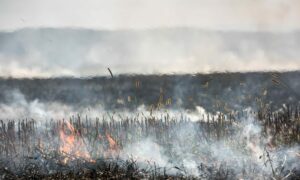
The Triple Planetary Crisis: Breaking Silos | INTECOL & Alternatiba 2022
31 August 2022 | 13:00–15:00 CEST | Club l’ésprit de Genève, CICG & Online | Webex

